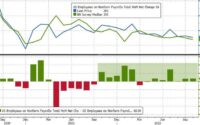Are central banks going bankrupt?
The bond market has had a bad year. And no one holds more bonds than central banks, which over the past decade have built a fixed-income portfolio worth well over $30 trillion. But do their mounting losses really matter?
Yes and no. Central banks are, of course, quite unique institutions. On the one hand, they have a balance sheet and an income statement like everyone else, and right now they don’t look great.
Toby Nangle treasures the The losses of the Bank of England alone are currently around £200 billion, and the Federal Reserve says it had incurred $330 billion in unrealized losses by the end of the first quarter. We think it’s safe to say the pain has increased since then.
On the other hand, central banks are constructs of sovereign states and can literally create money out of thin air, adding another dimension to the whole bankruptcy issue.
Seth Carpenter, Morgan Stanley’s chief economist, wrote one of the final papers on the subject when I was at the Fed ten years ago, and revisited the subject over the weekend. Given current events, we thought we’d share and paraphrase it liberally.
Central bank gains and losses are important. . . but only if they matter. Before the 1900s, the subject of economics was called “political economy.” Central bank losses that affect fiscal outcomes can have political ramifications, but the banks’ ability to conduct policy is not affected. . .
. . . Starting with the Fed, all income generated on the System Open Market Account portfolio, less interest expense, realized losses and operating expenses, is remitted to the US Treasury. Before the global financial crisis, these remittances averaged $20-25 billion per year; they rose to over $100 billion as the balance sheet grew. These transfers reduce the deficit and the borrowing requirement. Net profit depends on the (usually fixed) average coupon on assets, the proportion of liabilities that are interest-free (physical paper money), and the level of reserves and reverse repo balances, the costs of which fluctuate with the policy rate. From essentially zero in 2007, interest-bearing liabilities have exploded to nearly two-thirds of the balance sheet.
As the chart below shows, the US Federal Reserve’s net income (which has been returned to the US Treasury) has turned negative, and Morgan Stanley predicts losses will increase as interest rates rise.
Carpenter points out that most central banks, including the Fed, do not have a mark-to-market, so no losses have not been realized and don’t flow into the central bank’s income statement until they actually sell assets. But that naturally raises a lot of interesting questions.
So, what do losses mean? Is there an attack on capital? Bankruptcy? An inability to conduct monetary policy? No. First, the remittances to the Treasury end and the Treasury issues more debt. The Fed then accumulates its losses and, instead of reducing its capital, creates a ‘deferred asset’.1 When revenues turn positive, transfers remain at zero until losses are recouped; Imagine that the Fed faces a 100% tax rate and offsets current losses with future earnings. Profitability will eventually return as the currency will continue to grow, lower interest charges and QT will shrink interest-bearing liabilities.
Elsewhere, things are similar, but with local twists and turns, such as the Czech central bank’s long-standing negative equity position, or the fact that the Bank of England has received explicit reparation from the British government to recoup all losses when it QE gains began to pass.
The effect is essentially the same as with the Fed, but the political economy is different. Where HMT and the BoE share the responsibility, the Fed is on its own. Passive settlement for the BoE is difficult given the lumpy maturity structure of gold investments, while the Fed passively settles up to $95 billion per month. For the BoE, a one percentage point hike in bank interest rates cuts remittances by about £10bn a year, a significant amount for a country grappling with tax problems. The proposal to reduce costs by banning interest payments on reserves deserves further investigation. If no authority remains, the BoE would have to sell assets to regain monetary control and realize losses. The losses exist; it’s the timing that’s in question.
The ECB’s balance sheet is structured very differently, but the logic is similar. Our European team predicts the deposit rate at 2.5% in March next year, implying an ECB loss of around €40 billion next year. Bank deposits get the deposit rate, which will be much higher than the return on the portfolio. The BoJ’s balance sheet has grown similarly, but as of March (the latest available data), the BoJ was in an unrealized gain position. We believe that yield curve control (YCC) will be maintained until the end of Governor Kuroda’s term, but when it expires, if the JGB curve sells strongly, the losses could be large, although unrealized.
The most interesting variant is the Czech National Bank. The CNB has had a negative capital position for most of the past 20 years. Managing a small, open economy means focusing on the exchange rate, and most assets are denominated in foreign currencies. If the central bank is credible and the Czech koruna rises, the value of its assets falls. The same goes for the Swiss National Bank, whose profits and losses have increased by billions in a few years, but it has not lost control of the policy.
Negative equity of the central bank; are you coming to a Fed or BoE or ECB near you soon?
[ad_2]
Source link



